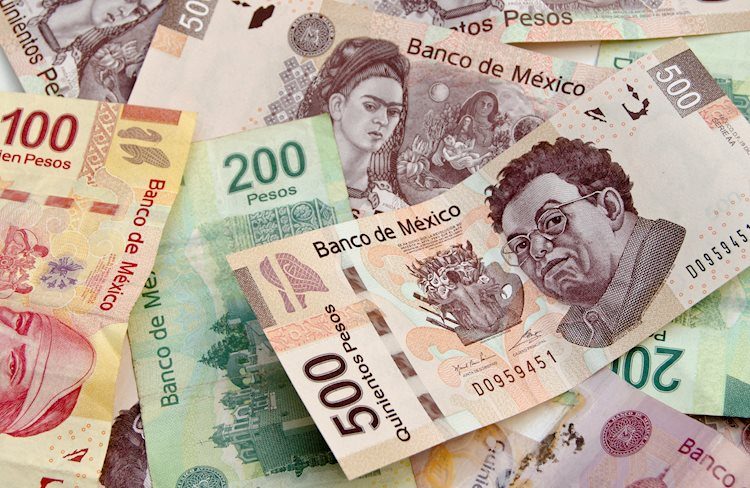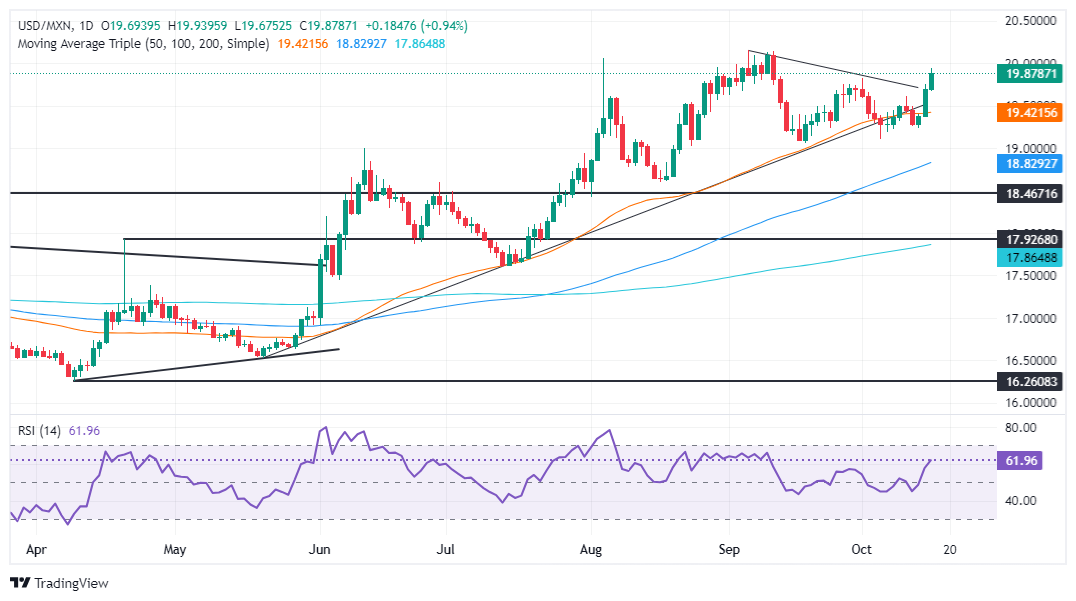- Mexican Peso weakened as US Dollar gains despite falling US yields.
- IMF downgrades Mexico’s 2024 GDP growth outlook, citing capacity constraints and tight monetary policy.
- US import prices fell sharply in September, while Fed’s Bostic remains optimistic about inflation hitting the 2% target.
The Mexican Peso depreciated in early trading on Wednesday as the US Dollar strengthened amid a mixed market mood with falling US Treasury yields. Softer inflation readings among developed countries suggest that further easing is coming, indicating that the global economy might slow down. The USD/MXN trades at 19.87, registering gains of 1%.
US equities are fluctuating as traders shifts focus toward small caps as the Russell 2000 outperforms the NASDAQ and S&P 500. Therefore, emerging market currencies sensitive to risk, like the Peso, remained on the back foot.
On Tuesday, the International Monetary Fund (IMF) revised Mexico’s economy downward to 1.5% in 2024 due to capacity constraints and a restrictive monetary policy. This is well below the 2.4% estimated by the Secretaria de Hacienda y Credito Publico (SHCP).
The IMF estimates GDP growth for the next year at 1.3% as inflation closes in on the Bank of Mexico’s (Banxico) 3% objective.
On the US front, the docket revealed that import prices fell the most in nine months in September due to the fall of energy prices. Meanwhile, Export prices fell on monthly and annual figures.
On Tuesday, Atlanta’s Fed President Raphael Bostic commented the US economy is performing well, and that he’s confident that inflation will hit the 2% target. He doesn’t foresee a recession, though he expects inflation to remain choppy and employment robust.
Ahead in the week, Thursday’s economic docket will feature the release of Retail Sales, Initial Jobless Claims, Industrial Production and further Fed speakers.
Daily digest market movers: Mexican Peso slumps as USD/MXN surges past 19.80
- Earlier during the North American session, the Mexican Peso touched a five-week low as the USD/MXN hit a high of 19.93, shy of the psychological 20.00 figure.
- The IMF said that a recent judicial reform creates “important uncertainties about the effectiveness of contract enforcement and the predictability of the rule of law.”
- Banxico’s survey revealed that economists estimate the central bank will lower rates by 50 bps for the rest of the year. The USD/MXN exchange rate is projected to end at 19.69, and the economy is expected to grow by 1.45% in 2024.
- US Import Prices plunged -0.4% MoM as expected in September. Export prices plummeted -0.7% more than estimates of -0.4% contraction and less than August’s -0.9%.
- Data from the Chicago Board of Trade via the December fed funds rate futures contract shows investors estimate 50 bps of Fed easing by the end of the year.
USD/MXN technical outlook: Mexican Peso nosedives as buyers eye USD/MXN at 20.00
The USD/MXN uptrend remains intact as the pair briefly surpassed 19.90 to hit multi-week highs. Momentum remains bullish as the Relative Strength Index (RSI) depicts. This would exert upward pressure on the exotic pair, which could clear the 20.00 figure as traders brace for safety ahead of the US election.
The USD/MXN next ceiling level would be 20.00. If surpassed, the next resistance would be the YTD high of 20.22, before challenging 20.50.
On the flip side, if USD/MXN tumbles below the October 1 high turned support at 19.82, it could exacerbate a test of the October 10 daily peak at 19.61. On further weakness, the next floor will be the October 4 swing low of 19.10 before testing 19.00.
Banxico FAQs
The Bank of Mexico, also known as Banxico, is the country’s central bank. Its mission is to preserve the value of Mexico’s currency, the Mexican Peso (MXN), and to set the monetary policy. To this end, its main objective is to maintain low and stable inflation within target levels – at or close to its target of 3%, the midpoint in a tolerance band of between 2% and 4%.
The main tool of the Banxico to guide monetary policy is by setting interest rates. When inflation is above target, the bank will attempt to tame it by raising rates, making it more expensive for households and businesses to borrow money and thus cooling the economy. Higher interest rates are generally positive for the Mexican Peso (MXN) as they lead to higher yields, making the country a more attractive place for investors. On the contrary, lower interest rates tend to weaken MXN. The rate differential with the USD, or how the Banxico is expected to set interest rates compared with the US Federal Reserve (Fed), is a key factor.
Banxico meets eight times a year, and its monetary policy is greatly influenced by decisions of the US Federal Reserve (Fed). Therefore, the central bank’s decision-making committee usually gathers a week after the Fed. In doing so, Banxico reacts and sometimes anticipates monetary policy measures set by the Federal Reserve. For example, after the Covid-19 pandemic, before the Fed raised rates, Banxico did it first in an attempt to diminish the chances of a substantial depreciation of the Mexican Peso (MXN) and to prevent capital outflows that could destabilize the country.

